


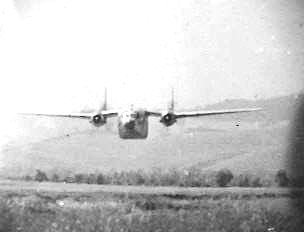




The AC-119s were not done to replace the AC-47s, but to do something the other gun ships couldn't. The Spooky didn't have enough fire power, and the AC-130s were too fast, and too vulnerable a target from the anti-aircraft fire. There were several 130s lost to enemy fire, but only one C-119, and that was because the idiots sent it out in the daytime. Everybody assumes that the 119s replaced the C-47s, and the C-130 gunships replaced the AC-119s, but thats incorrect, the C-119s were the third contract, not the second.
The last C-119 was retired in September 1975.
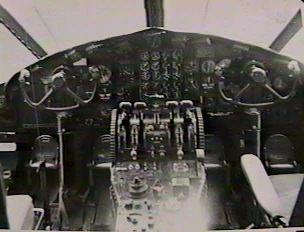
C-119 Cockpit.
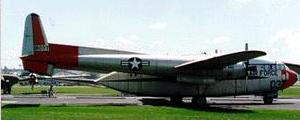
One of the rare C-119s that had the Beaver Tail Modification.
| Description | |||
|---|---|---|---|
| Manufacturer: | Fairchild Engine and Airplane Corp., Aircraft Division. Kaiser Manufaturing Co. | ||
| Locations Built: | Hagerstown, MD. Willow Run, Mich. | ||
| Cost: | $590,000 for basic aircraft (AC-119G modifications cost approx $623,000 for each aircraft; AC119K modifications cost approx $2.9 million for each aircraft) | ||
| Designation: | R4Q | ||
| Models/Variants: | C-119B, F, G, J, K, L, AC-119G Shadow, AC-119K Stinger. | ||
| Nickname: | Flying Boxcar | ||
| Equivalent to: | C-119C | ||
| Type: | Cargo / Transport | ||
| Specifications | |||
| Length: | 86' 5" | 26.34 M | |
| Height: | 26' 7"' | 8.10 M | |
| Wingspan: | 109' 3" | 33.30 M | |
| Wing-area: | 1447.00 Sq Ft | 134.42 Sq.M | |
| Empty Weight: | 39800.0 lbs | 18049.0 Kg | |
| Gross Weight: | 74000.0 lbs | 33560.0 Kg | |
| Propulsion | |||
| No.of Engines: | |||
| Powerplant: | Two Pratt & Whitney R-4360-20 (C-119Ks also had two GeneralElectric J85-GE-17 turbojets of 2,850l. static thrist in underwing pods) | ||
| Horsepower (each): | 3500 | ||
| Performance | |||
| Range: | 1770 miles | 2850.00 Km | |
| Max Speed: | 281.00 Mph | 452.00 Km/H | 244.32 Kt |
| Climb: | 1010.00 Ft/min | 307.83 M/min | |
| Ceiling: | 23900.0 Ft | 7284.40 M | |
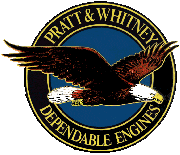
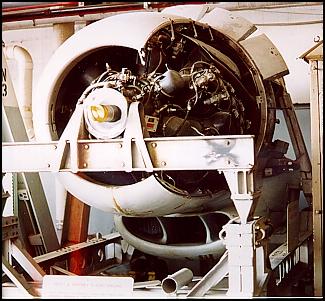
Pratt & Whitney R-4360
If my memory is correct; at take off settings the engines ran at 2800 RPM and pulled 62 inches of manifold pressure.

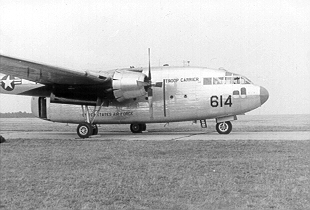

Fairchild C-82 Packet
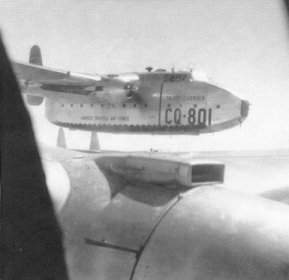
|
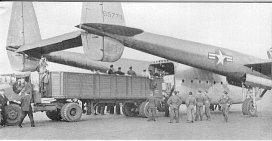 aircraft that could load at near
ground level. The single prototype first flew on
September 10, 1944; deliveries began in late 1945 and
ended in September 1948. Two hundred twenty-three
Packets were built-all but four were-As. It was
primarily used for cargo and troop transport, but it
also was used for paratroop operations and towing
gliders. Its capacity was 41 paratroops or 34
stretchers and and it had clam-shell rear doors that
allowed easy entry of trucks, tanks, artillery,
aircraft that could load at near
ground level. The single prototype first flew on
September 10, 1944; deliveries began in late 1945 and
ended in September 1948. Two hundred twenty-three
Packets were built-all but four were-As. It was
primarily used for cargo and troop transport, but it
also was used for paratroop operations and towing
gliders. Its capacity was 41 paratroops or 34
stretchers and and it had clam-shell rear doors that
allowed easy entry of trucks, tanks, artillery,
 and
other bulky cargo. Beginning in 1946, some C-82s were
assigned to Tactical Air Command troop carrier
squadrons and others to Military Air Transport
Service (MATS). Several were assigned to the Berlin
Airlift primarily to carry assembled vehicles into
the
city. In 1947, Fairchild developed an improved Packet
whitch the USAF accepted for production as the C-119.
It had more powerful engines, increased cargo and
weight capacity and a relocated flight deck.
and
other bulky cargo. Beginning in 1946, some C-82s were
assigned to Tactical Air Command troop carrier
squadrons and others to Military Air Transport
Service (MATS). Several were assigned to the Berlin
Airlift primarily to carry assembled vehicles into
the
city. In 1947, Fairchild developed an improved Packet
whitch the USAF accepted for production as the C-119.
It had more powerful engines, increased cargo and
weight capacity and a relocated flight deck.


| SPECIFACTIONS | |
|---|---|
| Span: | 106 ft. 6 in. |
| Length: | 77 ft. 1 in. |
| Height: | 26 ft. 4 in. |
| Weight: | 54,000 lbs. loaded |
| Engines: | Two Pratt & Whitney R-2800-85s of 2,100 hp. ea. |
| Crew: | Five |
| Cost: | $441.000 |
| Serial Number: | 48-581 |
| C/N: | 10216 |
| Other Registrations: | N4752C |
| Displayed as: | 45-57735 |
| PERFORMANCE | |
| Maximum Speed: | 250 mph. |
| Cruising Speed: | 162 |
| Range: | 2,140 miles |
| Service Ceiling: | 27,000 ft. |
|
Radio Information provided by Phill Chastain | |
| BC-348 H.F. reciever. ART-13 Multi Preset H.F. Transmitter,150 watts c.w. 100 watts am. | |
| V.H.F.-ARC-3 eight channel crystal control transciever. Approximatly 14 watts. | |
| D.F.-ARN-7 Auto directional finder good to home in to on A.F.N Frankfurt. ARN-11 Same frequency and range as the "7" but had to be manually orientated. Lot of planes got in trouble using this unit. ( Flying away instead of too.) | |
| Radio beacon reciever. (nomenclature escapes me) Used to pinpoint paratainer drops. | |

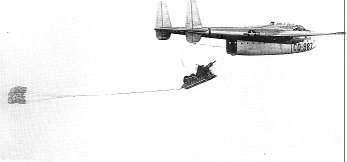


Pratt/Whitney R-2800